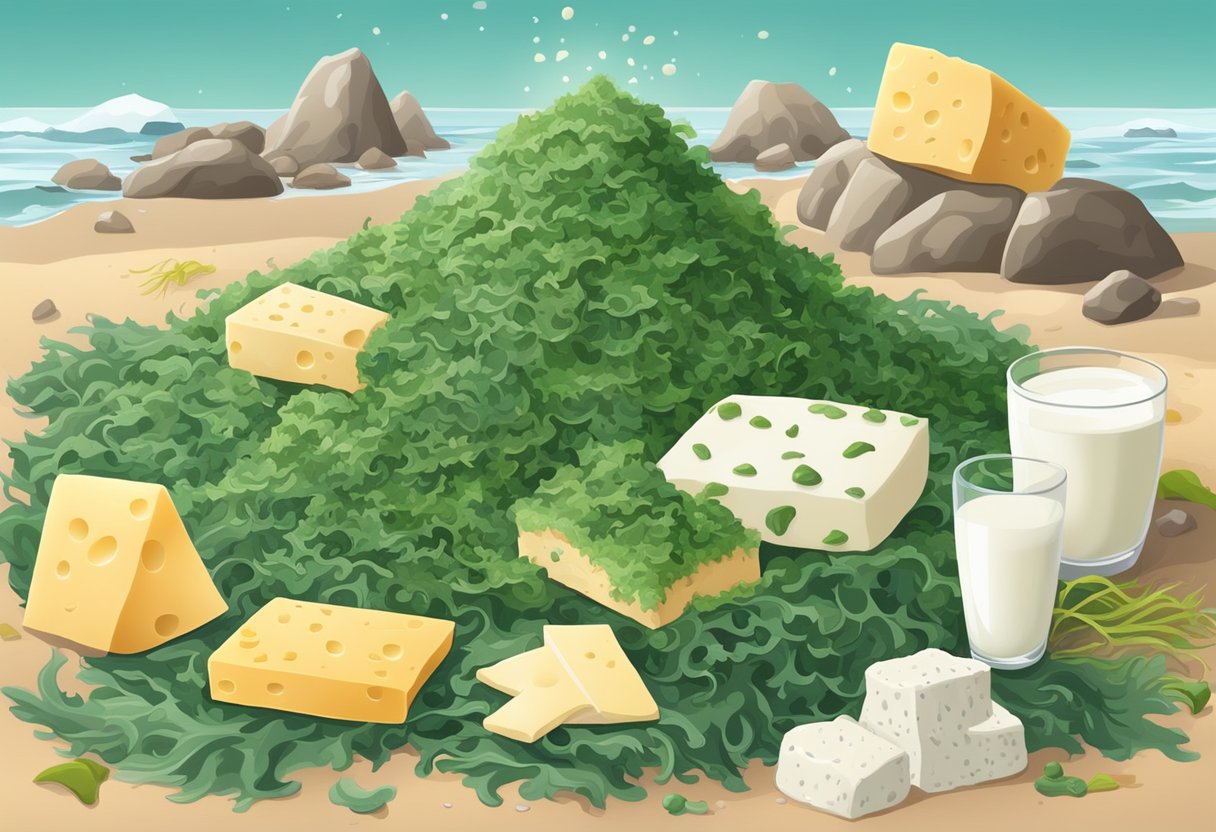Seaweed, a term generally used to describe various species of marine algae and plants, has been a staple in diets across coastal cultures for centuries. Often praised for its rich nutrient content, seaweed is gaining popularity as a versatile and healthful addition to a diverse array of dishes. An important nutrient that raises interest among health-conscious individuals is calcium, a mineral crucial for maintaining bone health, muscle function, and nerve transmission.

Investigation into the calcium content of seaweed reveals that it can indeed be a significant source of this essential mineral. While the amount of calcium varies among different types of seaweed, some species boast higher levels than many dairy products, positioning seaweed as an excellent alternative source of calcium, particularly for individuals following a vegan or lactose-intolerant diet. The bioavailability of seaweed-derived calcium, a measure of how easily the body can absorb the mineral, is also a focus of research, considering its implication for dietary recommendations and health benefits.
Key Takeaways
- Seaweed can be a rich source of calcium, necessary for bone health and other bodily functions.
- The calcium content in seaweed varies among species, with some having higher levels than dairy products.
- Consuming seaweed offers an alternative calcium source, suitable for vegan and lactose-intolerant diets.
Overview of Seaweed

Seaweed refers to diverse groups of marine algae and plants found in oceans, seas, and rivers around the world. They play a significant role in marine ecosystems, providing shelter and food for wildlife. Seaweeds are categorized into three main types based on their pigmentation: red, green, and brown algae.
- Red algae (Rhodophyta) usually inhabit warmer, tropical waters and have a distinctive red or purplish color.
- Green algae (Chlorophyta) are often found in freshwater as well as saltwater environments and are usually bright green.
- Brown algae (Phaeophyceae), including well-known varieties like kelp, are typically larger and predominantly found in colder, temperate seas.
Seaweed is also a staple in human diets, especially in Asian cuisines. It contains various vitamins, minerals, and fiber, contributing to its recognition as a health food. Notably, many types of seaweed are rich in iodine, which is essential for thyroid health, and they often contain other minerals like potassium, iron, and magnesium.
Commercially, seaweed is utilized in multiple sectors, including but not limited to food production, cosmetics, and agriculture. It serves as a thickening agent in products like ice cream and toothpaste, due to its content of compounds such as agar and carrageenan. Moreover, seaweed farming has become an important economic activity in several coastal regions, promoting sustainable aquaculture practices.
The study and cultivation of seaweed continue to gain global interest, thanks to its ecological benefits and versatile applications. Research in this field is expanding, exploring more ways that seaweed can contribute to environmental solutions and human well-being.
Calcium Essentials

Calcium is a crucial mineral for the human body. It is the most abundant mineral in the body and plays a vital role in strengthening bones and teeth, as well as in muscle function, nerve signaling, and heart health.
Adults typically require about 1,000 milligrams of calcium per day, although this amount varies with age and sex. Women over 50 and everyone over 70 should increase their intake to 1,200 milligrams per day.
The body does not produce calcium on its own. Therefore, it must be obtained through dietary sources or supplements. Common dietary sources of calcium include:
- Dairy products like milk, cheese, and yogurt
- Leafy green vegetables such as kale and broccoli
- Calcium-fortified foods like certain cereals and plant-based milk
Seaweed can also be a source of calcium. Different varieties of seaweed have varying amounts of calcium:
| Seaweed Type | Approximate Calcium Content |
|---|---|
| Wakame | 150 mg per 100g |
| Kombu (kelp) | 168 mg per 100g |
| Hijiki | 1400 mg per 100g |
It's important to consider the bioavailability of calcium from different sources. The body may absorb and utilize calcium from some sources better than from others.
Individuals with dietary restrictions, like vegans or those lactose intolerant, often seek alternative sources of calcium, making seaweed a potential addition to their diets. However, they should also be aware of their daily intake to avoid deficiencies.
Supplementation may be necessary in cases where dietary intake is insufficient, but it is recommended to consult with a healthcare provider before starting any supplement regimen.
Seaweed and Calcium Content

Seaweed is recognized for its nutritional value, including its calcium content. Calcium is an essential mineral for human health, vital for bone strength, muscle function, and nerve signaling. Different types of seaweed exhibit varying amounts of calcium.
Nori, commonly used in sushi, contains around 280 mg of calcium per 100 grams. Comparatively, Wakame, another popular type, offers slightly less, with around 150 mg of calcium per 100 grams. Kelp, a seaweed often found in supplement form, has approximately 168 mg of calcium per 100 grams.
These values position seaweed as a noteworthy source of calcium, especially for individuals following a plant-based diet. Seaweed's calcium content is generally bioavailable, meaning the body can absorb it effectively. Moreover, seaweed contains other nutrients that can aid in calcium absorption, like magnesium and vitamin K.
Factors such as seaweed species, water conditions, and preparation methods can influence the calcium content. For instance, dried seaweed tends to have a higher concentration of calcium compared to fresh, due to the reduction in water content.
| Type of Seaweed | Calcium Content (per 100g) |
|---|---|
| Nori | 280 mg |
| Wakame | 150 mg |
| Kelp | 168 mg |
Consuming seaweed can be an efficient way to enhance calcium intake. However, one should consider the type of seaweed and serving size to assess the actual calcium contribution to their diet. It's also crucial to note that excessive consumption of seaweed can lead to an intake of too much iodine, which can have adverse effects on thyroid health. Moderation is key.
Benefits of Calcium in Seaweed

Seaweed is a nutritious marine plant with a variety of health benefits. One notable component of seaweed is its calcium content. Calcium is crucial for maintaining strong bones and teeth, and seaweed provides a plant-based source of this mineral.
Calcium Content: Different types of seaweed exhibit varying levels of calcium. Generally, it is seen as a good source of calcium, particularly for those who do not consume dairy products. The calcium found in seaweed is essential for bone health and the prevention of osteoporosis.
Bodily Functions: In addition to bone health, calcium plays a role in nerve transmission, muscle function, and blood clotting. Seaweed's calcium contributes to these processes, offering a valuable addition to a balanced diet.
Absorption: The type of calcium found in seaweed may have higher bioavailability compared to other plant-based sources. This means that the body can absorb and utilize the calcium from seaweed more efficiently, enhancing its benefits. Additionally, seaweed often contains other nutrients that can aid in the absorption of calcium, like magnesium and vitamin C.
Heart Health: Researchers also connect adequate calcium intake with cardiovascular health. The calcium in seaweed can be part of a heart-healthy diet, helping to regulate blood pressure and reduce the risk of heart disease.
Dietary Inclusion: Including seaweed in one's diet is relatively simple. It can be eaten as a snack in dried form, incorporated into soups and salads, or used as a seasoning. Those seeking to boost their calcium intake might consider adding seaweed to their routine, reaping the benefits of this versatile and calcium-rich marine plant.
Incorporating Seaweed into Your Diet

Seaweed is a versatile ingredient that can boost the calcium content in one's meals. Here are a few ways one can include seaweed in their diet:
-
Soups and Broths: Adding seaweed such as kombu or wakame to soups and broths can infuse them with minerals. Simply soak the seaweed in water to soften it, then simmer it along with other ingredients.
-
Salads: Dried or fresh seaweed like nori or sea lettuce can be chopped and mixed into salads. It imparts a unique flavor and increases the nutritional value.
-
Snacks: Roasted seaweed snacks are readily available and can be a healthy, calcium-rich alternative to chips.
-
Sushi: Making sushi at home? Include nori sheets to wrap rolls of sushi, incorporating the benefits of seaweed with your favorite fillings.
-
Seasoning: Seaweed flakes or powders can be used as a seasoning. Sprinkle over dishes to add a savory taste known as "umami."
Tips for Cooking
- Rinse seaweed before use to remove excess salt.
- Cook seaweed with acidic ingredients, like lemon juice or vinegar, to soften its texture.
- Introduce seaweed gradually into your diet to adapt to its flavor.
| Seaweed Type | Suggested Use |
|---|---|
| Nori | Sushi, seasoning |
| Kombu | Soups, broths |
| Wakame | Soups, salads |
| Dulse | Snacks, salads |
Incorporating seaweed into one's diet is simple and can enrich one's meal with essential minerals, including calcium. It also offers a range of flavors and textures that can suit various dishes.
Conclusion
Seaweed is recognized as a nutrient-rich marine plant, notable for its calcium content. Different varieties of seaweed exhibit varying levels of calcium. For instance, wakame provides a substantial amount, contributing to daily dietary requirements.
A comparison of calcium sources shows that seaweed can be a good alternative to traditional dairy products, especially for individuals adhering to vegan or lactose-intolerant diets. Studies indicate that certain seaweeds, like kelp and hijiki, contain higher amounts than others, yet intake should be moderated due to potential iodine content and heavy metals.
Nutritionists suggest incorporating seaweed into a balanced diet as it offers other minerals and vitamins, along with calcium. For example, seaweed is also rich in iodine and vitamin K. Despite its benefits, consumers are advised to source seaweed from reputable suppliers to avoid contaminants.
As a versatile ingredient, seaweed can be easily added to meals in the form of dried flakes, sheets, or fresh varieties. Its inclusion supports not only calcium intake but also overall nutritional enhancement.
In summary, seaweed is an important source of calcium, particularly for those seeking non-dairy options. Its consumption should be informed by awareness of the type of seaweed and its respective nutrient profile.
Frequently Asked Questions
In this section, readers will find answers to common queries regarding the calcium content in seaweed and its implications for health.
Can regular intake of seaweed improve bone health?
Regular consumption of seaweed can contribute to bone health due to its calcium content. Seaweed varieties such as kelp and wakame are notable for their mineral density.
What are the nutritional components of seaweed?
Seaweed is rich in several nutrients, including calcium, iodine, magnesium, and vitamins A, C, E, and K. It is also a source of protein and fiber.
Are there any side effects associated with eating seaweed?
Consuming seaweed may lead to excessive iodine intake if eaten in large quantities. It can also contain heavy metals, so moderation and sourcing from clean waters are important.
How often can one safely eat dried seaweed?
One can safely eat dried seaweed a few times a week, ensuring it is sourced from uncontaminated waters to avoid the risk of heavy metal accumulation.
